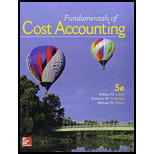
a.
Calculate the F division’s residual income if Company O does not acquire the new machine.
a.
Answer to Problem 45P
The residual income for division S is $3,000,000 if Company O does not acquire the new machine.
Explanation of Solution
Residual income:
Residual income is the amount of profit that is left after adjusting the cost of capital of the business. It is calculated by subtracting the profit after tax from the total cost of capital invested in the business unit.
Calculate the residual income if Company O does not acquire the new machine:
Thus, the residual income for division S is $3,000,000.
Working note 1:
Calculate the net asset value:
| Particulars | Amount |
| Opening asset value | $4,000,000 |
| Add: addition in the year | $5,000,000 |
| Total asset value | $9,000,000 |
| Less: | $1,500,000 |
| Less: depreciation on others | $1,250,000 |
| Net asset value | $6,250,000 |
Table: (1)
b.
Calculate the division F’s residual income if Company O acquires the new machine
b.
Answer to Problem 45P
The residual income is $860,000 if Company O acquires the new machine.
Explanation of Solution
Adjusted residual income:
Adjusted residual income is calculated by changing the profit and investment of the company as per the new business proposal.
Calculate the residual income if Company O acquires the new machine:
Thus, the residual income is $860,000 if Company O acquires the new machine.
Working note 2:
Calculate the net asset value:
| Particulars | Amount |
| Opening asset value | $4,000,000 |
| Add: improvement in the asset | $6,500,000 |
| Total asset value | $10,500,000 |
| Less: depreciation on others | $1,250,000 |
| Net asset value | $9,250,000 |
Table: (2)
Working note 3:
Calculate the after-tax divisional profit:
| Particulars | Amount |
| Operating profit | $3,750,000 |
| Less: loss on old equipment | $5,000,000 |
| Add: saving in the depreciation of old equipment | $1,500,000 |
| Net operating profit | $250,000 |
Table: (3)
c.
Calculate the residual income if the company acquires new machine and operates it according to specifications.
c.
Answer to Problem 45P
The residual income is $4,305,000 if the machine is operated as per the specifications.
Explanation of Solution
Residual income:
Residual income is the amount of profit that is left after adjusting the cost of capital of the business. It is calculated by subtracting the profit after tax from the total cost of capital invested in the business unit.
Calculate the residual income if the machine is operated as per the specifications:
Thus, the residual income is $4,305,000 if the machine is operated as per the specifications.
Working note 4:
Calculate the divisional operating income:
| Particulars |
Amount (a) |
% change (b) |
Net amount |
| Sales | $16,000,000 | +10% | $17,600,000 |
| Operating costs: | |||
| Variable | $2,000,000 | +10% | $2,200,000 |
| Fixed | $7,500,000 | -5% | $7,125,000 |
| Deprecation: | |||
| New equipment(6) | $1,500,000 | $2,000,000 | |
| Others | $1,250,000 | $1,250,000 | |
| Divisional operating profit | $5,025,000 |
Table: (4)
Working note 5:
Calculate the net asset value:
| Particulars | Amount |
| Opening asset value | $4,000,000 |
| Add: improvement in the asset | $6,500,000 |
| Total asset value | $10,500,000 |
| Less: depreciation on others | $2,500,000 |
| Less: depreciation on improved assets (6) | $2,000,000 |
| Net asset value | $6,000,000 |
Table: (5)
Working note 6:
Calculate the depreciation on new equipment:
Want to see more full solutions like this?
Chapter 14 Solutions
GEN COMBO FUNDAMENTALS OF COST ACCOUNTING; CONNECT 1S ACCESS CARD
- You have been asked to test the effectiveness of Ingo Corporation’s control of manually approving all purchases over $25,000. During the year, Ingo Corporation has made 1,000,000 purchases, of which 3,000 were over $25,000. Jian Zhang, CPA, your supervisor, asked you to use a tolerable deviation rate of 4 percent (although she expects the rate to be only approximately 0.50 percent) and a 5 percent risk of assessing control risk too low. Use the following to determine the planned assessed level of control risk and the assessed level of control risk. (Planned) Assessed Level of Control Risk Tolerable Deviation Rate Low 2−7% Moderate 6−12% Slightly below the maximum 11−20% Maximum Over 20% Expected Population Deviation Rate (as Percentages) Tolerable Deviation Rate 2% 3% 4% 5% 6% 7% 8% 9% 10% 15% 20% 0.00% 149(0) 99(0) 74(0) 59(0) 49(0) 42(0) 36(0) 32(0) 29(0) 19(0) 14(0) 0.25 236(1) 157(1) 117(1) 93(1) 78(1) 66(1) 58(1) 51(1) 46(1) 30(1) 22(1) 0.50 * 157(1)…arrow_forwardWhat is taxable income? Financial accountingarrow_forwardI need the correct answer to this financial accounting problem using the standard accounting approach.arrow_forward
- On September 1, Rivertown Inc. paid $9,000 for a six- month insurance policy that begins on September 1. What amount would appear in the Prepaid Insurance account on an adjusted trial balance dated December 31? A. $3,000 B. $1,500 C. $4,500 D. $0arrow_forwardPlease provide the accurate answer to this general accounting problem using appropriate methods.arrow_forwardsolve this question step by step and correct approach.arrow_forward
- Principles of Accounting Volume 2AccountingISBN:9781947172609Author:OpenStaxPublisher:OpenStax College
 EBK CONTEMPORARY FINANCIAL MANAGEMENTFinanceISBN:9781337514835Author:MOYERPublisher:CENGAGE LEARNING - CONSIGNMENT
EBK CONTEMPORARY FINANCIAL MANAGEMENTFinanceISBN:9781337514835Author:MOYERPublisher:CENGAGE LEARNING - CONSIGNMENT Managerial Accounting: The Cornerstone of Busines...AccountingISBN:9781337115773Author:Maryanne M. Mowen, Don R. Hansen, Dan L. HeitgerPublisher:Cengage Learning
Managerial Accounting: The Cornerstone of Busines...AccountingISBN:9781337115773Author:Maryanne M. Mowen, Don R. Hansen, Dan L. HeitgerPublisher:Cengage Learning  Financial Reporting, Financial Statement Analysis...FinanceISBN:9781285190907Author:James M. Wahlen, Stephen P. Baginski, Mark BradshawPublisher:Cengage Learning
Financial Reporting, Financial Statement Analysis...FinanceISBN:9781285190907Author:James M. Wahlen, Stephen P. Baginski, Mark BradshawPublisher:Cengage Learning




